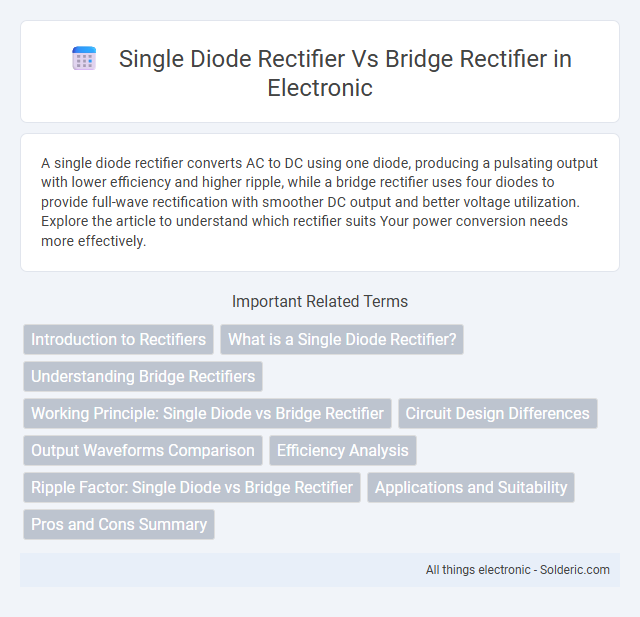A single diode rectifier converts AC to DC using one diode, producing a pulsating output with lower efficiency and higher ripple, while a bridge rectifier uses four diodes to provide full-wave rectification with smoother DC output and better voltage utilization. Explore the article to understand which rectifier suits Your power conversion needs more effectively.
Comparison Table
| Feature | Single Diode Rectifier | Bridge Rectifier |
|---|---|---|
| Number of Diodes | 1 | 4 |
| Output Type | Half-wave DC | Full-wave DC |
| Efficiency | ~40.6% | ~81.2% |
| Output Voltage | Less (approx. 0.318 x input RMS voltage) | Higher (approx. 0.9 x input RMS voltage) |
| Ripple Frequency | Same as AC input frequency | Twice the AC input frequency |
| Transformer Usage | Can use center-tapped transformer or none | Does not require center-tapped transformer |
| Complexity | Simple, fewer components | More complex, more components |
| Application | Low-power, simple DC supply | High-efficiency DC power conversion |
Introduction to Rectifiers
Single diode rectifiers convert AC to DC by allowing current flow through a single diode, producing pulsating direct current with only half of the AC waveform utilized. Bridge rectifiers employ four diodes arranged in a bridge configuration, enabling full-wave rectification that converts both halves of the AC input into DC output, resulting in higher efficiency and smoother voltage. Compared to single diode rectifiers, bridge rectifiers provide improved output voltage, reduced ripple, and better transformer utilization.
What is a Single Diode Rectifier?
A Single Diode Rectifier converts alternating current (AC) into direct current (DC) by allowing current to pass through only one half-cycle of the AC waveform, resulting in pulsating DC output. It is a simple, cost-effective solution ideal for low-power applications but has a lower efficiency due to only utilizing half the AC cycle. In contrast, a Bridge Rectifier uses four diodes arranged in a bridge configuration to convert both half-cycles of AC into DC, providing higher output voltage and smoother DC output.
Understanding Bridge Rectifiers
Bridge rectifiers use four diodes arranged in a bridge configuration to convert AC input into a full-wave DC output, improving efficiency compared to single diode rectifiers that only provide half-wave rectification. This design allows both halves of the AC waveform to be utilized, resulting in a smoother and higher average output voltage. Bridge rectifiers are ideal for applications requiring higher power and reduced ripple voltage compared to single diode rectifiers.
Working Principle: Single Diode vs Bridge Rectifier
A single diode rectifier allows current to flow in only one direction, converting AC to pulsating DC by blocking the negative half cycles, resulting in half-wave rectification. In contrast, a bridge rectifier uses four diodes arranged in a bridge configuration to convert both positive and negative half cycles of AC into pulsating DC, achieving full-wave rectification. This difference in working principles makes the bridge rectifier more efficient in converting AC to DC with less ripple voltage compared to the single diode rectifier.
Circuit Design Differences
A single diode rectifier uses one diode to convert AC to DC, resulting in half-wave rectification with only one half of the input waveform utilized, causing lower efficiency and higher ripple. In contrast, a bridge rectifier employs four diodes arranged in a bridge configuration, enabling full-wave rectification by utilizing both halves of the AC cycle, which improves output smoothness and efficiency. The bridge circuit design also eliminates the need for a center-tapped transformer, simplifying transformer requirements and reducing overall system cost in many applications.
Output Waveforms Comparison
The output waveform of a single diode rectifier exhibits a pulsating DC with significant gaps and a frequency equal to the AC input, leading to higher ripple content. In contrast, a bridge rectifier produces a waveform with a higher pulse frequency, effectively doubling the ripple frequency and providing a smoother DC output. This results in improved efficiency and reduced filtering requirements for the bridge rectifier compared to the single diode configuration.
Efficiency Analysis
Single diode rectifiers have lower efficiency due to the use of only one diode, resulting in a higher voltage drop and increased power loss during half-wave rectification. Bridge rectifiers utilize four diodes arranged in a bridge configuration, achieving full-wave rectification that doubles the output frequency and reduces ripple, thereby improving overall efficiency. The improved conduction path in bridge rectifiers minimizes voltage drop and energy waste, making them more suitable for applications demanding higher power conversion efficiency.
Ripple Factor: Single Diode vs Bridge Rectifier
The ripple factor of a single diode rectifier typically ranges around 1.21, indicating higher AC content in its output, whereas the bridge rectifier exhibits a significantly lower ripple factor of approximately 0.48, resulting in smoother DC output. A bridge rectifier uses four diodes in a full-wave configuration, doubling the frequency of the ripple and reducing the amplitude compared to the half-wave single diode rectifier. Consequently, bridge rectifiers enhance power supply efficiency and reduce filtering requirements due to their lower ripple factor.
Applications and Suitability
Single diode rectifiers are commonly used in low-power applications such as signal demodulation and simple power supplies where cost and circuit simplicity are critical. Bridge rectifiers are preferred for higher power requirements, providing full-wave rectification that results in smoother DC output, making them suitable for industrial power supplies and battery charging systems. Your choice depends on the need for efficiency, output quality, and the complexity acceptable in your electronic design.
Pros and Cons Summary
A single diode rectifier offers simplicity and lower cost with fewer components, making it ideal for low-power applications, but it produces a pulsating DC output with higher ripple, reducing efficiency. Bridge rectifiers provide full-wave rectification, resulting in smoother DC output and higher efficiency but require four diodes, increasing complexity and voltage drop. The choice between the two depends on the application's power requirements, desired output quality, and cost constraints.
Single diode rectifier vs Bridge rectifier Infographic

 solderic.com
solderic.com